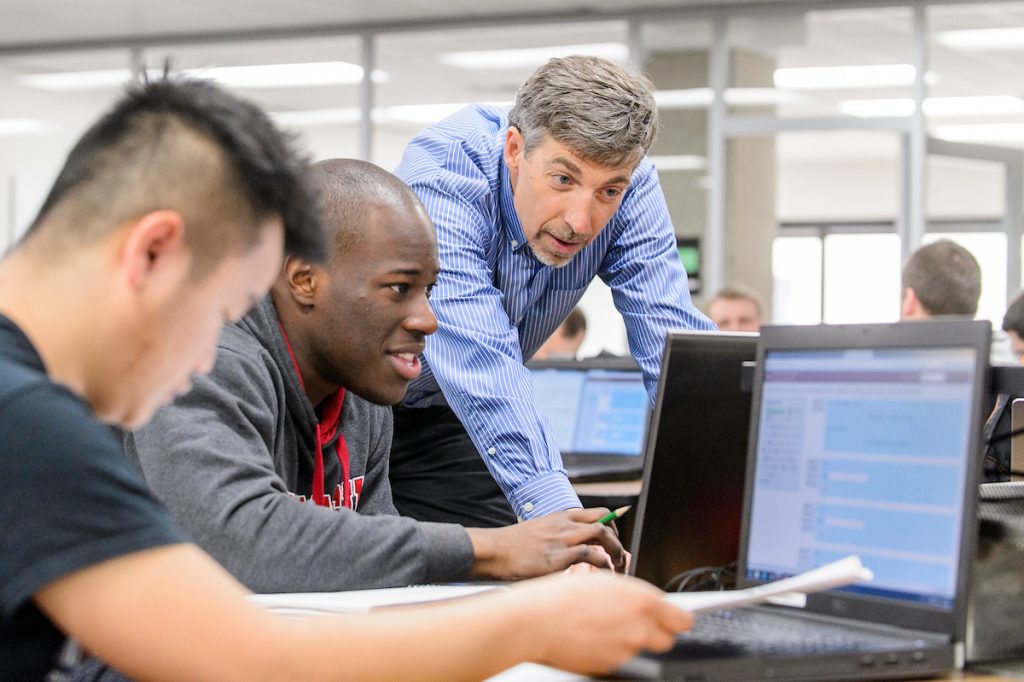
As libraries shift more and more books from physical shelves to online repositories in our increasingly digital world, what’s left behind?
Space.
But not to worry: campus libraries know exactly what to do with their newly available square footage. The demand for social–academic spaces is rising, says Ed Van Gemert, university librarian and vice provost for UW–Madison Libraries. While the UW’s libraries continue to be home to plenty of print resources — including one of the most robust special and archival collections in the country — they’re doubling as popular destinations for undergraduates.
Giving new life to campus spaces isn’t limited to the libraries. A campuswide effort, spearheaded by an initiative called Educational Innovation, is improving the student experience through active, accessible, and inclusive learning opportunities. As part of the initiative, campus libraries are establishing spaces where students can study, work, research, collaborate, access technology, harness creativity, lounge, socialize, eat, caffeinate, and feel safe — all in one setting.
Space for Collaboration
Having the capacity to create such collaborative spaces is a true commodity, says Van Gemert, noting that the proliferation of digital resources allows UW Libraries to accommodate the increasing demand and partner with departments around campus.
Case in point: Memorial Library, perhaps the quietest and most serious of campus libraries. Although it’s home to the notorious study carrels (more commonly, and less endearingly, coined by UW students as “study cages”) and dissuades loud talking, there’s growing demand for collaborative spaces within the library, says Lesley Moyo, associate university librarian for public services.

Remember the card catalog, a rather tedious, but necessary, system for tracking down books? The very space that housed Memorial Library’s card catalog, Room 224, is in the beginning stages of becoming a collaborative hub for undergrads. The planned redesign includes small- and large-group study areas, a small projection room for practicing presentations, comfortable seating, and movable glass boards.
That redesign is inspired by the popularity of several other new spaces. In 2010, Educational Innovation spurred the Wisconsin Collaboratory for Enhanced Learning (WisCEL), which promotes 21st-century instruction and active learning. With centers at College Library — the designated undergrad library — and Wendt Commons, WisCEL offers training, educational technology, computerized testing, and flexible rooms. More than forty courses, spanning thirty departments, hold their classes in WisCEL centers each year.
This past spring, Steenbock Library partnered with the Wisconsin Institute for Science Education and Community Engagement (WISCIENCE) and the Office of Undergraduate Advising to open the BioCommons, a learning space geared toward students in the biological sciences and designed carefully with first-year students, first-generation college students, and underrepresented students in mind. Occupying the lower — now appropriately called “garden” — level of Steenbock Library, the space features large, collaborative booths, study rooms, a multipurpose area with projection capabilities, and private spaces for student services. Decked out with plants and, well, life, BioCommons invites students to build community and innovate.
“More than I like to admit, I hear things like, ‘Nobody reads books anymore,’ or, ‘People don’t use libraries,’ ” Van Gemert says. “It’s not true. The libraries on campus are used more than ever — just in different ways.”
‘It’s a Digital World’
With their digital resources, libraries remain heavily active and influential on campus. More than forty locations feature varying library services, and each year, they collectively serve more than 4 million physical visitors. UW Libraries, whose website is second only to the UW’s home page in usage, also fulfills a staggering number of requests through its digital services:
- There are an average of 773,063 requests for content from licensed online databases per day
- The top 30 online databases are used an average of 13,071 times each per day
- The University of Wisconsin Digital Collection — a repository of books, images, and audio-visual materials digitized by campus libraries — is used an average of 21,738 times per day
“[Having] 4 million visitors is a substantial physical presence,” says Lee Konrad, associate university librarian for technology strategies and data services. “But at the same time, we also know that the use of our electronic resources dwarfs the use of our physical ones. It doesn’t negate the important role that physical collections and spaces contribute to the library experience; rather, it is a simple reflection that the use of online materials is exponentially greater than that.”
The digital growth of campus libraries mirrors the realities of 21st-century customer service, says Moyo. She likens library service to modern banking. Just as banks allow patrons to transfer money, deposit checks, or complete other tasks digitally, libraries should allow students to reserve books, search databases, or pay late fees online. And just as patrons have the ability to visit a physical bank location for more complex transactions and in-person support, students should have similar access at libraries.
“We’re one aspect of their life,” Moyo says. “We don’t want to be the weak link, where they think, ‘Ugh, I have to go to the library.’ We want to be their prime destination, and a high priority in their academic life.”
This dedication to service is front and center with the “Ask a Librarian” online chat, which UW Libraries has offered in some form for more than a decade. Badger Parent tested out the chat and reached Nancy McClements, head of reference for Memorial Library, who provided insight on how students are utilizing the service.
According to McClements, quotidian questions include how to reserve textbooks, how to borrow laptops and other devices, and how to produce presentation materials. Naturally, when deadlines for class papers surface, so do questions about how to find books and articles relating to a particular topic.
Students have also found ways to show off their creativity through the online service. “Sometimes they chat with us to tell us that someone is too loud in the library, but they don’t want to shush them,” McClements wrote during our chat session. “Then we send our security person, and the loud person is none the wiser as to who blew the whistle.”
Librarians receive chat requests from around 10,000 people each year, including students who are studying abroad, international students who may feel more comfortable typing out a question than verbalizing it, and students who are close by, but don’t want to lose their high-demand tables or leave their laptops unattended. “Students will use online chat while sitting across from a librarian,” Van Gemert says. “It’s a digital world.”
Evolving Needs
As teaching and learning needs evolve, the role of the librarian evolves right along with them. While traditional services — such as providing print and digital materials, or helping students navigate catalogs and databases — remain relevant, librarians are now starting to help students create content, Konrad says.
Papers and exams are no longer a classroom monopoly. Now, students often need to produce visual presentations and multimedia assets, and libraries are offering technologies and support to guide students. “We track needs and try to respond accordingly, and not just in a reactive way,” Konrad says. “We’re trying to anticipate needs and be proactive, so we have the kinds of spaces, both physical and virtual, that students and scholars need [to thrive].”
In an era of digital resources and collaborative spaces, one of Van Gemert’s favorite quotes rings as true as ever: “No one ever graduated from a library, but no one ever graduated without one.”